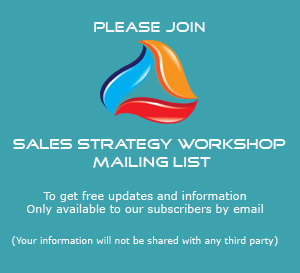Introduction to Open-Ended Questions
This is the third article in our series on sales questions. If you haven’t had a chance to read them, you should take a look at the first two articles in this series; “Why, The Importance of Sales Questions – Part 1” and “Five Reasons Why You Need To Use Sales Questions – Part 2.” We also did an audio podcast, “Asking The Right Sales Questions Can Lead to Sales Success.” All of these can give you a good foundation for using sales questions.
Two Types of Sales Questions
As you start to master using sales questions, the first thing that you will notice is that sales questions fall into two categories:
- Open-ended questions
- Close-ended questions
Both open-ended questions and close-ended questions are essential. When you use them correctly, your sales will start to skyrocket. You will begin to see dramatic improvements in the following:
- Your sales numbers
- A shorter sales cycle
- More satisfied customers
- More money in your pocket
In this article, we will closely examine the open-ended questions.
The Open-ended Question
To understand the prospect’s problems or challenges, you need open-ended questions.
If you want your prospect to relax, you use open-ended questions.
You want to use open-ended questions when you want them to think about the answer they give.

Open-ended questions seek out answers that require the prospect to think. You use open-ended questions when you want the prospect to give you an unfiltered response. In most cases, you never ask a question to which you don’t know the answer. This is not the case when you decide to use an open-ended question.
The Five W’s and an H
If you have ever taken a journalism course, you probably remember who, what, where, and why. This represented the critical information you needed when investigating a story. This is known as the five W’s and an H. Five W’s and an H represent the six (6) questions for any investigation. In the early stages of the sales process, that’s precisely what you are doing. You are investigating why someone would invest in your product or service. The five W’s and an H are who, what, where, when, why, and how.
- Who, other than yourself, will make the buying decision?
- What is the most important benefit you expect to gain from this purchase?
- Where will you be using this service?
- When do you need to have delivery?
- Why are you considering this purchase now?
- How will the buying decision be made?
When searching for information and trying to establish rapport, use Open-Ended-Questions. Here are the three main characteristics of the open-ended question:
- They ask the person to reflect and think.
- They provide you with their feelings and opinions.
- They hand over control of the conversation to the other person.
That last point is essential. You hand control over to the other person. Never use an open-ended question when going into a close decision point. You don’t want to lose control.
When to Use Open-Ended Questions
By now, you understand that one of the reasons we ask questions is to get information. So when do you ask open-ended questions?
You should use open-ended questions in two major areas of the sales presentation. Use open-ended questions in the Warm-up and the Needs Analysis.
The Warm Up
One long-held belief is that they won’t buy from you if they don’t like you. How do you get them to like you? By letting them talk.
The best way to do this is to use open-ended questions. Research has also shown that the more you let someone talk and you become the perfect listener, the more they like you. It’s also a fact that if a prospect likes you, they are more likely to buy from you.
It’s a good idea to start the warm-up stage of the sales process by asking open-ended questions. This could be your first visit or your tenth. Don’t start off the meeting talking about business. Talk about what they want to talk about. Your goal is to help them relax and become comfortable with you.
Open-Ended Questions To Use In The Warm-Up
In the warm-up, ask questions about them and their company. Look for items in their office that tell you something about them outside the office. Some of these may not follow the 5 W’s and an H, but they show how you can arrange your questions to get to the same end:
“That’s a nice picture; how old are your kids?” Everyone likes to talk about their family.
“I see you are a golfer. Do you get out much?” This is good if you have seen pictures of them on a golf course or golf clubs in the corner.
“Wow, you’ve been with the company for ten years. Did you start in this office?” This is because you saw a service plaque on their desk.
As you can see, none of these questions can harm you in the sales process. Each gives the prospect a chance to talk and for you to listen. They relax, and you get information to help you in the sales process. I would suggest that you take some time to develop a list of open-ended questions that you could use in the warm-up. This is best done during your pre-call planning.
Open-Ended Questions to Use in the Needs Analysis
The needs analysis often called the discovery phase, is one of the most essential parts of the sales process. This is the stage of the sales process where you gather the information you will need to develop your solution. You want information that tells you what to do to make the sale. Your goal is to understand their buying process, challenges, and needs.
“Why did you decide to see us today?”
“What led you to look at our company?” This allows them to start to describe their current challenges and their reason for looking to make a purchase.
“How do you like the service you are getting from your present provider?”
“What improvement would you like to see in a new solution?”
“Where do you expect to see the biggest benefit of this solution?”
“What challenges are you looking to solve with this solution?”
If they are using a competitor’s product or service now, we need to know how we get them to switch.
“Who in addition to yourself, will be involved in making the buying decision?”
You need to make sure you are communicating with the decision-maker.
“How does your company make its purchasing decisions for this product type?”
“How soon do you need to have this solution in place?”
“If we could improve what you are currently doing, what improvement would you like to see?”
In the needs analysis, we must understand what they are looking for and what they will base the buying decision on. These examples are generic but examples of open-ended questions you could ask to help uncover needs.
Keys to Using Open-ended Questions
- Use open-ended questions when you want the prospect to think; before they answer.
- Use open-ended questions when the answer doesn’t hurt you and it can provide you with more information.
- Never use open-ended questions when you need to maintain control.
- Never use open-ended questions in the close.
Now you should understand open-ended questions and when they can be used. Take some time to write out ten open-ended questions. Write out five that you could use in the warm-up. Then write out five you could use in the needs analysis.
Open-ended questions can contribute significantly to your sales success, so learn how to make the most of them. In the next article, we will talk about the first of the close-ended question, the tie down.
Visit Sales Management Workshop Podcast
If you have a chance, check out Sales Management Workshop. The podcast and blog provide sales management information to anyone responsible for leading a sales team.
The Sales Management Workshop podcast, covers topics like:
- Sales Planning
- Territory development
- Coaching your sales team
- Hiring
- Training and more
Sales Management Workshop Podcast On iTunes
You can find the Sales Management Workshop Podcast at http://www.salesmanagementworkshop.com/ or follow this link to Sales Management Workshop Podcast in the Apple iTunes Store, and it's free.




